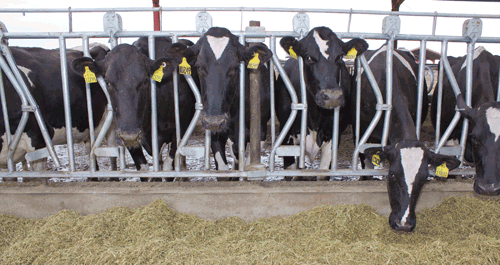The author has a dairy nutrition consulting business, Paradox Nutrition, LLC, in West Chazy, N.Y.
A crucial goal for dairy nutritionists is to provide as much energy as possible for maximum milk production while maintaining the health of the cow. A key issue in high-producing cows is subclinical acidosis which is primarily caused by excessive starch and inadequate long fiber in the diet.

Subclinical acidosis occurs when rumen pH drops below 5.8.
To avoid this, feed high-cow rations of 21 to 27 percent starch and 4 to 6 percent sugar.
Scientists have found that rumen pH can vary from about 7.0 (neutral) to less than 5.0 (acidic). Subclinical acidosis occurs when the pH of the cow's rumen drops below 5.8. This can limit milk production due to reductions in fiber digestion, microbial protein production, and energy production.
For optimum rumen health, it is generally recommended that high-cow rations contain 21 to 27 percent starch and 4 to 6 percent sugar. Rumen microbes ferment starches and sugars to form volatile fatty acids (VFA), with propionate being a significant end product. Excessive accumulation of propionate in the rumen reduces pH and encourages the growth of lactate-producing microbes.
As lactate, a stronger acid than propionate, accumulates in the rumen, it further reduces pH. At equivalent levels of total dietary starch and sugar, however, one ration containing a large amount of fast-fermenting starches such as barley, high-moisture corn, or bakery product may cause acidosis, whereas a ration containing a more slowly degradable starch like dry ground corn may not.
Without adequate effective fiber and saliva production, the risk of rumen acidosis rises. Cows need to ruminate about 8 hours per day. To ensure good rumination, at least 15 percent of the particles in the diet should exceed 1.5 inches in length.
Feeding management and cow comfort will, in part, determine how much starch and sugar can be fed. If a total mixed ration (TMR) is fed rather than feeding components individually, higher levels of starch and sugar can be included. Subclinical acidosis issues can result if cows are sorting out the grain before consuming forage. Anything that reduces feed access time can result in more subclinical acidosis.
Monitoring pH changes
In the past, researchers often measured rumen pH in fistulated cows a few times per day and then averaged those measurements to compare average daily rumen pH between different treatments. But, just taking the average of a few rumen pH measurements tells us very little about what is really going on in the rumen.
Nutritionists have known for a long time that the pH of the rumen fluctuates throughout the day. It was hard to measure this variation until the last decade when scientists began to use indwelling pH sensors placed in rumen-fistulated cows. These devices can be left for many days in the rumen and automatically record rumen pH every minute and store the data.
This technology has allowed researchers to look at the effect of diet, feeding behavior, and feed additives in rumen pH variation. Instead of focusing on average rumen pH, the goal is to reduce the number of minutes per day when the rumen pH is below 5.8.
Changes in feeding order, starch availability, fiber length, and cow comfort can all affect the number of minutes per day when rumen pH is low. Cows that are fed a TMR in group situations may have a different eating pattern than cows in tie stalls due to overcrowding or holding area time. Both factors likely affect rumen pH. Differences associated with housing type may be important factors for commercial dairies when evaluating feed additives that are intended to impact within-day rumen pH.
At low rumen pH, the rumen microbes must spend valuable energy to get rid of the excessive amount of hydrogen ions coming into them. This is energy which would otherwise be available for microbial growth. Certain bacteria have more problems with rumen acidity than others. The fiber digesters are particularly sensitive.
In the 1980s, Canadian researchers reported that production of VFAs dropped from 80 to 50 mmoles per day when pH in an artificial rumen was reduced from 7 to 5. That is a 37.5 percent reduction in energy produced for the cow by the rumen microbes.
Researchers in Spain repeatedly monitored rumen pH in a study with loose-housed dairy cows. They found that, when they added a specific live yeast to the diet, it reduced the amount of time during the day when rumen pH was less than 6.0 from 9.5 hours per day to 4.1 hours per day.
More recently, researchers in Spain looked at the significance of the total pH drop. Using artificial rumen fermenters, they reduced the pH to either 5.1 or 5.6 for 4 hours per day. At 5.1, fiber digestibility fell. But, at 5.6, there was no significant problem.
So, if we can find ways to reduce the hours of low pH from, for example, 6 hours per day to 2 hours per day, we might boost energy production in the rumen.
On-farm assessment
We now have the tools to assess rumen pH on commercial dairies in nonfistulated cows. A New Zealand company (Kahne Limited, Auckland, NZ) manufactures wireless rumen sensors to assess rumen pH, temperature, and pressure. The rumen sensors are placed into the cow's rumen using a large, customized balling gun. Measurements are then taken.
The data is retrieved from the cow every few weeks. To do this, the rumen sensor is first activated by passing a wand along the cow's side. Then, the data from the rumen sensor is received via a field receiver which is connected by a cable to a computer. With this data from the cow, mean daily pH, minimum daily pH, maximum daily pH, daily pH range, duration of day with pH less than 5.8 (minutes per day), and area with pH less than 5.8 (pH x minutes per day) can all be determined.
It is eye-opening to the fairly major swings high-producing cows can have in rumen pH during the day. These cows can often be making a lot of milk with a decent fat test and have no signs of laminitis. But, small changes in the diet such as moderating the speed of starch fermentation, reducing TMR sorting, or using additives to control pH, can create a better rumen environment for more hours of the day.
A crucial goal for dairy nutritionists is to provide as much energy as possible for maximum milk production while maintaining the health of the cow. A key issue in high-producing cows is subclinical acidosis which is primarily caused by excessive starch and inadequate long fiber in the diet.

To avoid this, feed high-cow rations of 21 to 27 percent starch and 4 to 6 percent sugar.
Scientists have found that rumen pH can vary from about 7.0 (neutral) to less than 5.0 (acidic). Subclinical acidosis occurs when the pH of the cow's rumen drops below 5.8. This can limit milk production due to reductions in fiber digestion, microbial protein production, and energy production.
For optimum rumen health, it is generally recommended that high-cow rations contain 21 to 27 percent starch and 4 to 6 percent sugar. Rumen microbes ferment starches and sugars to form volatile fatty acids (VFA), with propionate being a significant end product. Excessive accumulation of propionate in the rumen reduces pH and encourages the growth of lactate-producing microbes.
As lactate, a stronger acid than propionate, accumulates in the rumen, it further reduces pH. At equivalent levels of total dietary starch and sugar, however, one ration containing a large amount of fast-fermenting starches such as barley, high-moisture corn, or bakery product may cause acidosis, whereas a ration containing a more slowly degradable starch like dry ground corn may not.
Without adequate effective fiber and saliva production, the risk of rumen acidosis rises. Cows need to ruminate about 8 hours per day. To ensure good rumination, at least 15 percent of the particles in the diet should exceed 1.5 inches in length.
Feeding management and cow comfort will, in part, determine how much starch and sugar can be fed. If a total mixed ration (TMR) is fed rather than feeding components individually, higher levels of starch and sugar can be included. Subclinical acidosis issues can result if cows are sorting out the grain before consuming forage. Anything that reduces feed access time can result in more subclinical acidosis.
Monitoring pH changes
In the past, researchers often measured rumen pH in fistulated cows a few times per day and then averaged those measurements to compare average daily rumen pH between different treatments. But, just taking the average of a few rumen pH measurements tells us very little about what is really going on in the rumen.
Nutritionists have known for a long time that the pH of the rumen fluctuates throughout the day. It was hard to measure this variation until the last decade when scientists began to use indwelling pH sensors placed in rumen-fistulated cows. These devices can be left for many days in the rumen and automatically record rumen pH every minute and store the data.
This technology has allowed researchers to look at the effect of diet, feeding behavior, and feed additives in rumen pH variation. Instead of focusing on average rumen pH, the goal is to reduce the number of minutes per day when the rumen pH is below 5.8.
Changes in feeding order, starch availability, fiber length, and cow comfort can all affect the number of minutes per day when rumen pH is low. Cows that are fed a TMR in group situations may have a different eating pattern than cows in tie stalls due to overcrowding or holding area time. Both factors likely affect rumen pH. Differences associated with housing type may be important factors for commercial dairies when evaluating feed additives that are intended to impact within-day rumen pH.
At low rumen pH, the rumen microbes must spend valuable energy to get rid of the excessive amount of hydrogen ions coming into them. This is energy which would otherwise be available for microbial growth. Certain bacteria have more problems with rumen acidity than others. The fiber digesters are particularly sensitive.
In the 1980s, Canadian researchers reported that production of VFAs dropped from 80 to 50 mmoles per day when pH in an artificial rumen was reduced from 7 to 5. That is a 37.5 percent reduction in energy produced for the cow by the rumen microbes.
Researchers in Spain repeatedly monitored rumen pH in a study with loose-housed dairy cows. They found that, when they added a specific live yeast to the diet, it reduced the amount of time during the day when rumen pH was less than 6.0 from 9.5 hours per day to 4.1 hours per day.
More recently, researchers in Spain looked at the significance of the total pH drop. Using artificial rumen fermenters, they reduced the pH to either 5.1 or 5.6 for 4 hours per day. At 5.1, fiber digestibility fell. But, at 5.6, there was no significant problem.
So, if we can find ways to reduce the hours of low pH from, for example, 6 hours per day to 2 hours per day, we might boost energy production in the rumen.
On-farm assessment
We now have the tools to assess rumen pH on commercial dairies in nonfistulated cows. A New Zealand company (Kahne Limited, Auckland, NZ) manufactures wireless rumen sensors to assess rumen pH, temperature, and pressure. The rumen sensors are placed into the cow's rumen using a large, customized balling gun. Measurements are then taken.
The data is retrieved from the cow every few weeks. To do this, the rumen sensor is first activated by passing a wand along the cow's side. Then, the data from the rumen sensor is received via a field receiver which is connected by a cable to a computer. With this data from the cow, mean daily pH, minimum daily pH, maximum daily pH, daily pH range, duration of day with pH less than 5.8 (minutes per day), and area with pH less than 5.8 (pH x minutes per day) can all be determined.
It is eye-opening to the fairly major swings high-producing cows can have in rumen pH during the day. These cows can often be making a lot of milk with a decent fat test and have no signs of laminitis. But, small changes in the diet such as moderating the speed of starch fermentation, reducing TMR sorting, or using additives to control pH, can create a better rumen environment for more hours of the day.
This article appears on page 617 of the September 25, 2011 issue of Hoard's Dairyman.










